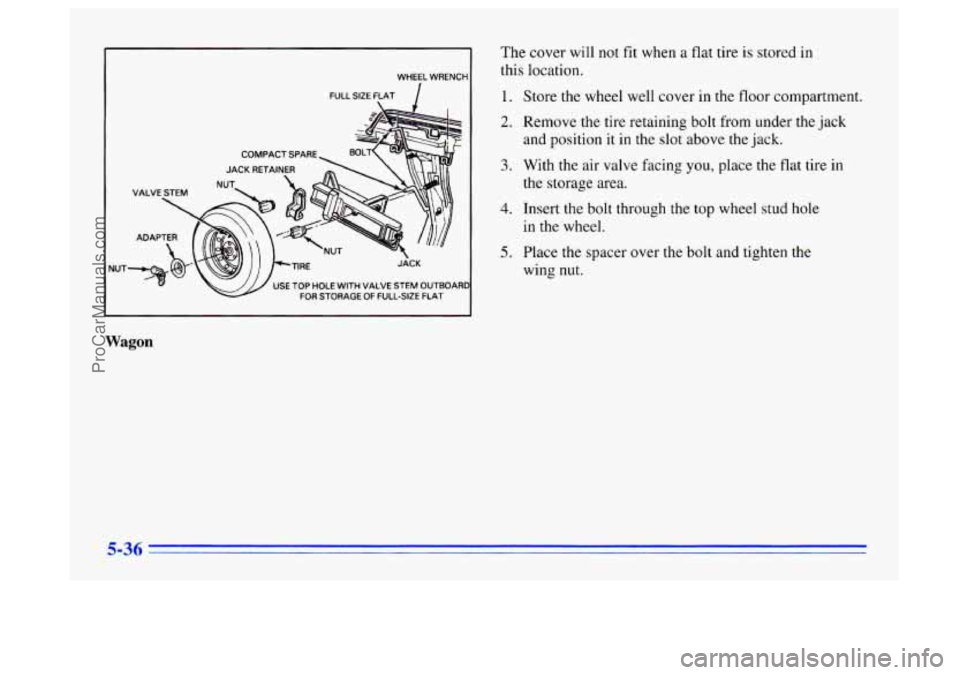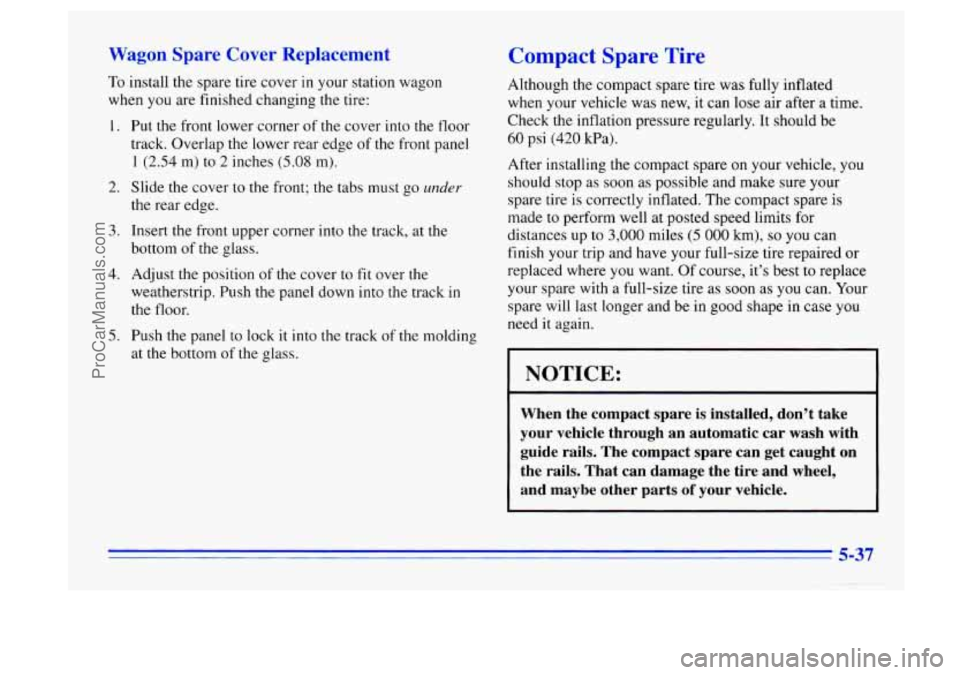1996 BUICK CENTURY tire size
[x] Cancel search: tire sizePage 158 of 340

Loading Your Vehicle
TIRE-LOADING INFORMATION VEHICLE CAP.
WT.
FRT. CTR. RR. TOTAL LBS.
MAX. LOADING & GVWR SAME AS VEHICLE
CAPACITY WEIGHT
XXX COLD TIRE
TIRE SIZE SPEED PRESSURE
RTG PSI/KPa
FRT.
RR.
SPA.
IF TIRES ARE HOT, ADD 4PS1/28KPa
SEE OWNER’S MANUAL FOR ADDITIONAL
INFORMATION
Two labels on your vehicle show how much weight it
may properly carry. The Tire-Loading Information label
found on the rear edge of the driver’s door tells you the
proper size, speed rating and recommended inflation
pressures for the tires on your vehicle. It also gives
you
important information about the number of people that
can be in your vehicle and
the total weight that you can
carry. This weight
is called the vehicle capacity weight
and includes the weight
of all occupants, cargo and all
nonfactory-installed options.
MFD BY GENERAL MOTORS CORP
DATE GVWR GAWR FRT GAWR RR
THIS VEHICLE CONFORMS TO ALL APPLI-
CABLE
U.S. FEDERAL MOTOR VEHICLE
SAFETY, BUMPER,
AND THEFT PREVENTION
STANDARDS
IN EFFECT ON THE DATE OF
MANUFACTURE SHOWN ABOVE.
I
The other label, is the Certification label, found on the
rear edge of
the driver’s door. It tells you the gross
weight capacity of your vehicle, called the GVWR
(Gross Vehicle Weight Rating). The GVWR includes
the weight
of the vehicle, all occupants, fuel and cargo.
Never exceed the GVWR for your vehicle, or the Gross
Axle Weight Rating (GAWR) for either the front or
rear axle.
If
you do have a heavy load, you should spread it out.
Don’t carry more than 160 lbs.
(72 kg) in the sedan
trunk or
300 lbs. (136 kg) in the wagon rear area.
ProCarManuals.com
Page 202 of 340

NUT
WHEEL WREN0
FULL SIZE FLAT /
COMPACT SPARE,
JACK RETAINER m \\!J JJ In-
JACK
USE TOP HOLE WITH VALVE STEM OUTBOARI:
FOR STORAGE OF FULL-SIZE FLAT
Wagon
The cover will not fit when a flat tire is stored in
this location.
1.
2.
3.
4.
5.
Store the wheel well cover in the floor compartment.
Remove the tire retaining bolt from under the jack
and position it in the slot above the jack.
With the air valve facing you, place the flat tire in
the storage area.
Insert the bolt through the top wheel stud hole
in the wheel.
Place the spacer over the bolt and tighten the
wing
nut.
5-36
ProCarManuals.com
Page 203 of 340

Wagon Spare Cover Replacement
To install the spare tire cover in your station wagon
when you are finished changing the tire:
1.
2.
3.
4.
5.
Put the front lower corner of the cover into the floor
track. Overlap the lower rear edge of the front panel
1 (2.54 m) to 2 inches (5.08 m).
Slide the cover to the front; the tabs must go under
the rear edge.
Insert the front upper corner into the track,
at the
bottom
of the glass.
Adjust the position
of the cover to fit over the
weatherstrip. Push the panel down into the track
in
the floor.
Push the panel
to lock it into the track of the molding
at the bottom of the glass.
Compact Spare Tire
Although the compact spare tire was fully inflated
when your vehicle was new, it can
lose air after a time.
Check the inflation pressure regularly. It should be
60 psi (420 kPa).
After installing the compact spare on your vehicle, you
should stop as soon as possible and make sure your
spare tire is correctly inflated. The compact spare is
made to perform well at posted speed limits for
distances up to
3,000 miles (5 000 km), so you can
finish your trip and have your full-size tire repaired or
replaced where
you want. Of course, it’s best to replace
your spare with a full-size tire as soon as you can. Your
spare will last longer and be in good shape in case
you
need it again.
NOTICE:
When the compact spare is installed, don’t take
your vehicle through an automatic car wash with
guide rails. The compact spare can get caught on
the rails. That can damage the tire and wheel,
and maybe other parts
of your vehicle.
5’ -7
ProCarManuals.com
Page 247 of 340

When It’s Time for New Tires
I1 One way to tell when it’s d
time for new tires is to
check the treadwear
indicators, which will
appear when your tires have
only
1/16 inch (1.6 mm) or
less of tread remaining.
You need a new tire if any of the following statements
are true:
You can see the indicators at three or more places
around the tire.
0 You can see cord or fabric showing through the
tire’s rubber.
The tread or sidewall is cracked, cut or snagged deep
enough to show cord or fabric.
0 The tire has a bump, bulge or split.
The tire has a puncture, cut or other damage that
can’t be repaired well because of the size or location
of the damage.
Buying New Tires
To find out what kind and size of tires you need, look at
the Tire-Loading Information label.
The tires installed on your vehicle when it was new had
a Tire Performance Criteria Specification
(TPC Spec)
number on each tire’s sidewall. When you get new tires,
get ones with that same TPC Spec number. That way
your vehicle will continue to have tires that are designed
to give proper endurance, handling, speed rating,
traction, ride and other things during normal service on
your vehicle. If your tires have an all-season tread
design, the TPC number will be followed by an
“MS”
(for mud and snow).
If you ever replace your tires with those not having a
TPC Spec number, make sure they are the same size,
load range, speed rating
and construction type (bias,
bias-belted
or radial) as your original tires.
5-41
ProCarManuals.com
Page 248 of 340

/I CAUTION:
Mixing tires could cause you to lose control while
driving.
If you mix tires of different sizes or types
(radial and bias-belted tires), the vehicle may not
handle properly, and you could have a crash.
Using tires of different sizes may also cause
damage to your vehicle. Be sure to use the same
size and type tires on all wheels.
It’s all right to drive with your compact spare,
though. It was developed for use
on your vehicle.
Uniform Tire Quality Grading
The following information relates to the system
developed by the United States National Highway
Traffic Safety Administration, which grades tires by
treadwear, traction and temperature performance. (This
applies only to vehicles sold
in the United States.) The
grades are molded on the sidewalls
of most passenger
car tires. The Uniform Tire Quality Grading system does
not apply to deep tread, winter-type snow tires,
space-saver or temporary use spare
tires, tires with
nominal rim diameters of
10 to 12 inches (25 to 30 cm),
or
to some limited-production tires.
While the tires available on General Motors passenger
cars and light trucks may vary with respect
to these
grades, they must also conform to Federal safety
requirements and additional General Motors Tire
Performance Criteria (TPC) standards.
6-42
ProCarManuals.com
Page 251 of 340

Used Replacement Wheels
~~
m -q
Putting a used wheel on your vehicle is
dangerous. You can’t know how it’s been used or
how many miles it’s been driven. It could fail
suddenly and cause an accident.
If you have to
replace a wheel, use a new
GM original
equipment wheel.
Tire Chains
NOTICE:
Use tire chains only where legal and only when
you must. Use only
SAE Class “S” type chains
that are the proper size for your tires. Install
them on the front tires and tighten them as
tightly
as possible with the ends securely
fastened. Drive slowly and follow the chain
manufacturer’s instructions.
If you can hear the
chains contacting your vehicle, stop and retighten
them.
If the contact continues, slow down until it
stops. Driving too fast or spinning the wheels
with chains on will damage your vehicle.
6-45
ProCarManuals.com
Page 268 of 340

Refrigerant (R=l34a), Air Conditioning*
2.2L (Code 4) .................................................... 1.75 lbs. (0.8kg)
3.1L V6 (Code
M) ................................................. 2.0 Ibs. (0.9kg)
*See “Air Conditioning Refrigerants” later in this section.
Power Steering
Pump Only 2.2L
L4 (Code 4) .................................................. 1 pint (0.47 L)
3.1L V6 (Code M) ................................................. 1 pint (0.47 L)
2.2L L4 (Code 4) ................................................ 1.7 pints (0.82 L)
Wheel Nut Torque ............................................ 100 lb-ft (140 N-m)
Type
...................................................... RH/LH 4.75 pin RRpin
Length
............................................... 18” (457 mm) 16” (406 mm)
Complete System
3.1L V6
(Code M) ................................................ 1.6 pints (0.75 L)
Windshield Wiper Blade Replacement
Fuel Tank
................
Tire Pressures, Sizes ........
NOTE: All capacities are approx
manual. .i
................................... 16.5
gallons 62.4 L
........ See Tire-Loading Information label on driver’s door.
mate. When adding, be sure to fill to the appropriate level, as recommended in this
6-62
ProCarManuals.com